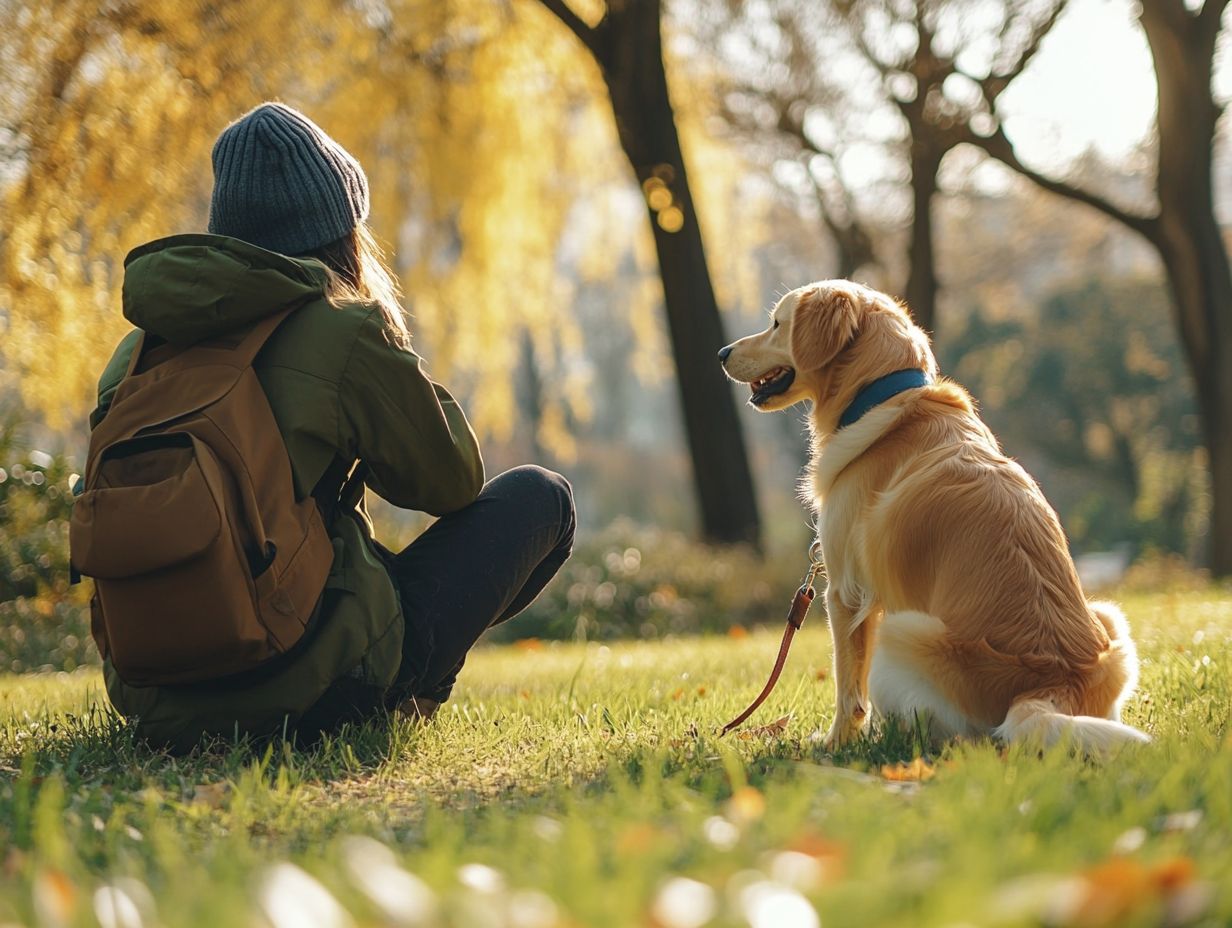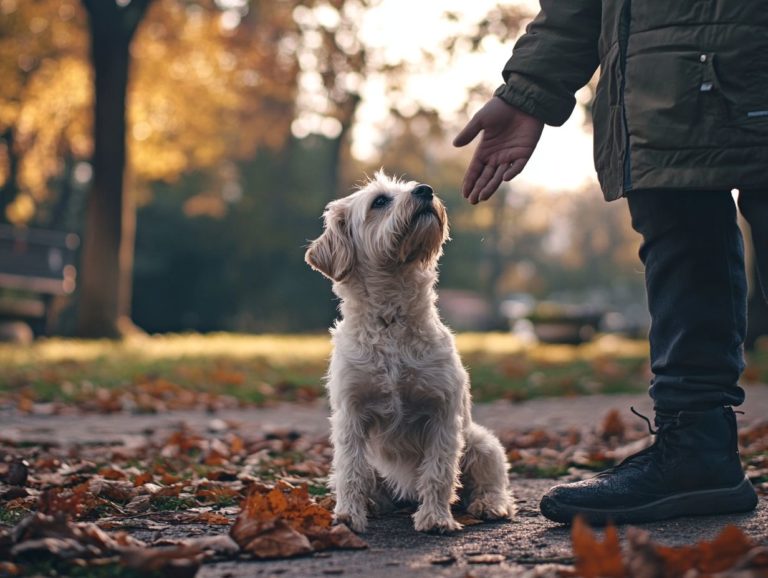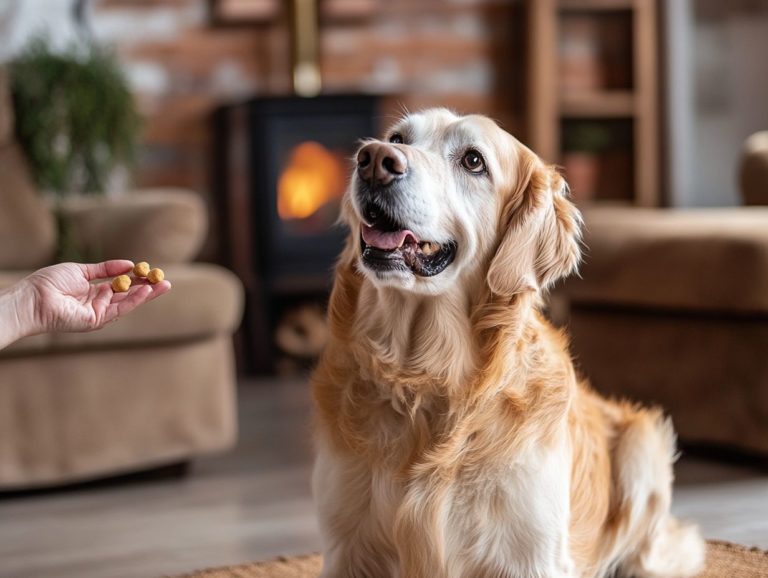Understanding Leash Training for Anxious Dogs
Is your dog anxious on walks? Let s turn those nerves into confidence! Leash training is an essential skill for any dog, especially for those who experience anxiety. Anxious dogs face unique challenges when it comes to walking on a leash. Proper training is crucial for both their well-being and your peace of mind.
This guide will help you recognize signs of anxiety, prepare for effective leash training, and implement techniques that create a positive experience.
Whether you re starting from scratch or overcoming obstacles, you ll find practical tips designed to help your furry friend feel comfortable and confident during walks.
Contents
- Key Takeaways:
- What is Leash Training and Why is it Important?
- Signs of Anxiety in Dogs
- Preparing for Leash Training
- Creating a Calm and Safe Environment
- Steps for Leash Training an Anxious Dog
- Rewarding Methods
- Dealing with Setbacks and Challenges
- Common Challenges and How to Overcome Them
- Tips for Maintaining a Successful Leash Training Routine
- Frequently Asked Questions
- What is leash training for anxious dogs?
- Why is it important to leash train an anxious dog?
- How do I know if my dog needs leash training?
- What are some tips for leash training an anxious dog who may be experiencing panic?
- Can leash training help improve my dog’s anxiety and overall behavior?
- What if my dog doesn’t respond well to leash training and remains fearful?
Key Takeaways:

- Leash training is crucial for anxious dogs to ensure their safety and well-being.
- Identifying signs of anxiety in dogs is the first step toward successful leash training.
- Maintaining a calm and positive environment, using gradual introduction, and positive reinforcement techniques are key to leash training an anxious dog.
What is Leash Training and Why is it Important?
Leash training is an essential part of responsible dog ownership. It allows your furry companion to stroll confidently in various settings. It involves using the leash to help your dog understand boundaries and engage positively with the world while addressing any anxiety or fear-related behaviors.
Effective leash training greatly enhances the experience for both you and your dog. It creates a supportive and calm atmosphere during your walks. Get ready to explore exciting training methods, such as gradually getting used to new situations and positive reinforcement, ensuring that your pet is well-behaved and ready for enjoyable outings.
Signs of Anxiety in Dogs
Recognizing the signs of anxiety in dogs is essential for effective leash training. By understanding these signs, you can ensure that your pet feels comfortable and secure during walks, fostering a positive experience for both of you.
Identifying Anxiety in Dogs
Identifying anxiety in dogs can be challenging. It often appears through subtle behavioral changes that you might easily overlook. You may notice shifts in body language like a lowered head, pinned ears, or a tucked tail each signaling discomfort or distress.
Vocalizations serve as critical indicators; anxious dogs might whine, bark excessively, or emit unusual growls when they feel unsettled. Compulsive behaviors, such as excessive licking or pacing, may also emerge as coping mechanisms in response to anxiety.
By tuning into these cues, you can gain a deeper understanding of your canine companion’s emotions. This ensures you take the right steps to create a comfortable and secure environment for them.
Preparing for Leash Training
Preparation is essential for leash training your dog. It involves gathering the right supplies and creating a safe, comfortable environment that fosters a positive training experience.
Gathering Necessary Supplies
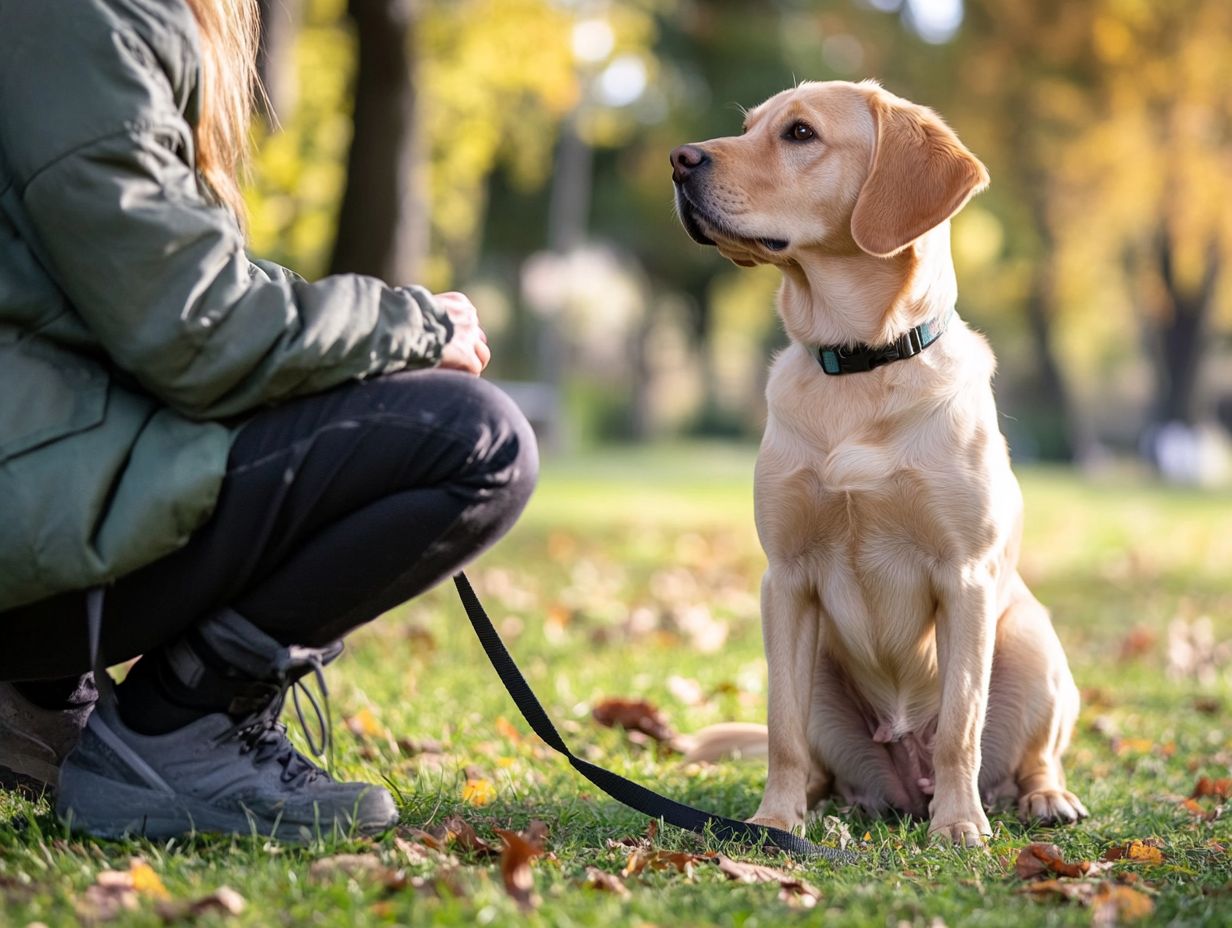
To train your dog effectively on a leash, gather the right supplies: a durable leash, a comfortable collar or harness, and some high-value treats for positive reinforcement.
These essentials streamline the training process and enhance your dog s overall experience. Opting for a harness instead of a traditional collar can significantly alleviate strain on your pup s neck. This reduces the risk of injury especially for smaller breeds or those with respiratory concerns. The right harness distributes pressure evenly across your dog s body, making walks more enjoyable and promoting better leash manners.
High-value treats serve as powerful motivators, reinforcing the behaviors you want during training sessions. By investing in these supplies, you create an atmosphere of comfort and safety, setting the stage for a positive and enjoyable training journey.
Start your leash training adventure today and watch your dog thrive!
Creating a Calm and Safe Environment
Creating a calm and safe environment is key to successful leash training. It helps reduce anxiety and makes your dog feel comfortable during sessions.
Eliminate distractions like loud noises or other pets to create a focused and fun training experience! Make sure the training space has no interruptions, allowing your dog to concentrate on commands and build their confidence.
A comfortable area with the right temperature and a soft surface will further enhance engagement and reduce stress.
When your dog feels secure in their surroundings, they are more likely to respond positively and eagerly participate in training. This lays the groundwork for effective learning and improved behavior.
Steps for Leash Training an Anxious Dog
Leash training an anxious dog demands a careful strategy. Embrace gradual introduction techniques and rewarding methods, including utilizing obedience training to ease anxiety, to ensure a positive and rewarding experience for both you and your furry companion.
This thoughtful approach sets the stage for a harmonious relationship on the leash.
Rewarding Methods
Utilizing rewarding methods is essential for successful leash training, as it encourages desired behaviors while helping to reduce your dog s anxiety.
Incorporate treats and enthusiastic praise into your training sessions to create an environment where your dog feels secure and motivated to learn.
This approach not only reinforces good behaviors, like walking calmly by your side, but also fosters a positive association with the leash.
For anxious dogs, consistent rewards serve as a confidence booster, gradually alleviating their fears.
Over time, as your dog begins to associate leash time with positive experiences like enjoying a favorite treat or receiving affection you’ll notice an improvement in their overall demeanor. This transformation makes walks more enjoyable for both you and your furry companion.
Dealing with Setbacks and Challenges
Encountering setbacks and challenges during leash training is common among dog owners. By grasping how to effectively navigate these hurdles, you can pave the way for a more successful and rewarding experience for both you and your canine companion.
Common Challenges and How to Overcome Them
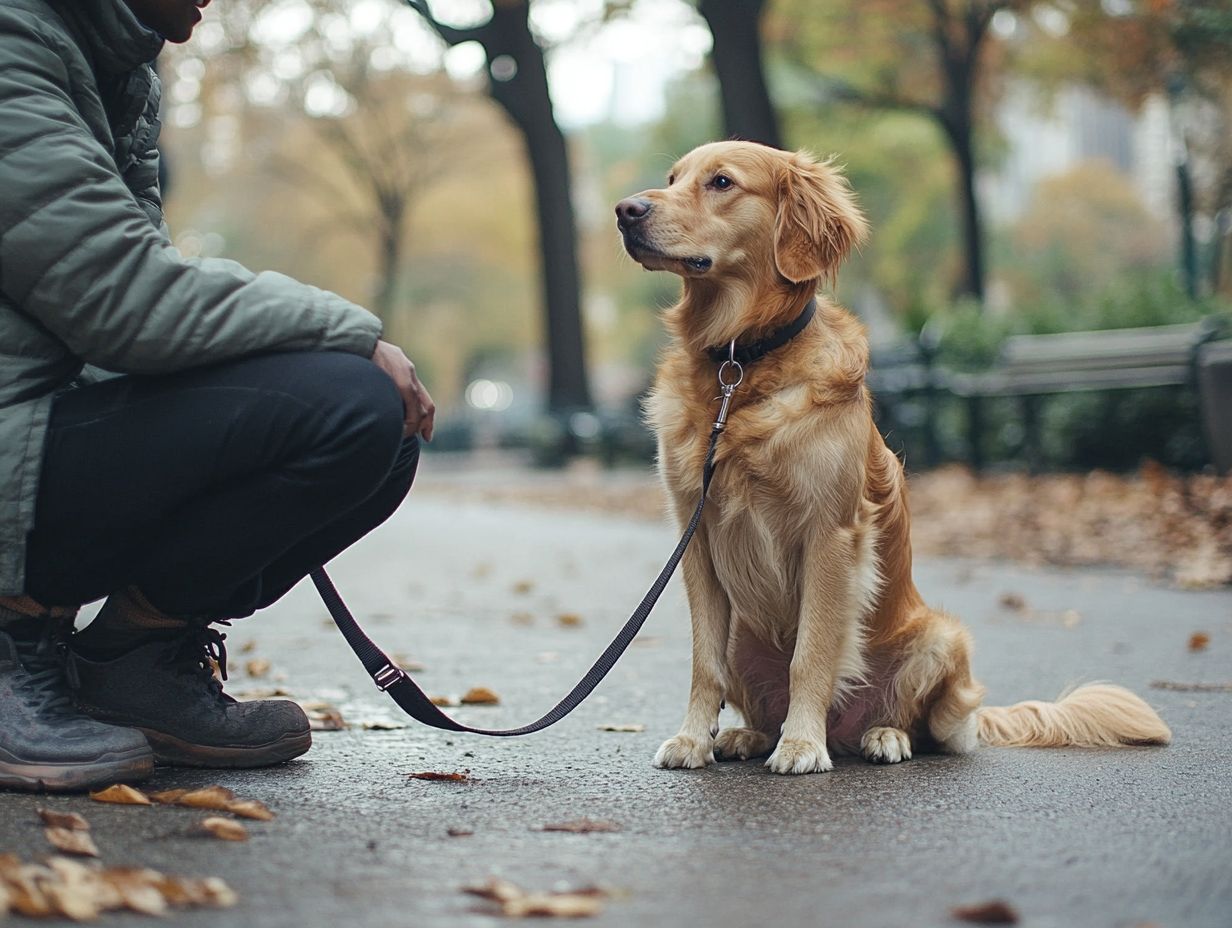
Common challenges during leash training may include pulling, barking, or signs of anxiety, but with the right strategies, you can effectively manage these issues.
For instance, you might notice your dog becoming overly excited when encountering other dogs or people, leading to chaotic walks. To tackle this, practice focus exercises that encourage your dog to maintain eye contact and stay calm in the midst of distractions.
Consistency in training is vital. Incorporate short sessions with positive reinforcement to significantly enhance your dog s behavior on the leash.
Recognizing and responding to your dog s body language is crucial, as this awareness can help prevent negative experiences. With enough patience and a supportive approach, even the most unruly dogs can learn to walk calmly by your side.
Tips for Maintaining a Successful Leash Training Routine
To maintain a successful leash training routine, reinforce learned behaviors while ensuring your dog feels comfortable and confident during walks.
This approach not only strengthens your bond with your pet but also transforms walk time into a positive experience for both of you.
Consistency and Patience are Key
Consistency is crucial for leash training because it reinforces desired behaviors. It builds trust between you and your dog.
By sticking to a regular training schedule and using the same commands and signals, you create a clear understanding for your pet. For example, consistently using the command “heel” during walks reinforces that guiding behavior.
Patience is also vital. Some dogs may need more time to adjust to a leash, especially those with excitable or anxious temperaments.
As a trainer, remaining calm and supportive during these initial hurdles not only enhances your dog s comfort but also creates a positive atmosphere. With this steady approach, walks will transform into a joyful experience for both of you!
Frequently Asked Questions
What is leash training for anxious dogs?
Leash training for anxious dogs is the process of teaching them to walk calmly and confidently on a leash, while also understanding the needs of anxious pets to prevent signs of anxiety or fear.
Why is it important to leash train an anxious dog?
Leash training is important for anxious dogs because it helps them feel more secure and in control during walks, improving their overall well-being. Incorporating positive reinforcement techniques for anxious pets can further reduce anxiety levels.
How do I know if my dog needs leash training?
If your dog shows signs of anxiety or fear while on a leash, such as pulling, lunging, or freezing, it may benefit from leash training.
What are some tips for leash training an anxious dog who may be experiencing panic?
Some helpful tips include starting in a low-stress environment, using positive reinforcement techniques (rewarding good behavior), and gradually increasing the duration and difficulty of training sessions.
Can leash training help improve my dog’s anxiety and overall behavior?
Yes, leash training can help improve your dog’s anxiety by providing structure and predictability during walks, making them feel more secure and less anxious.
What if my dog doesn’t respond well to leash training and remains fearful?
If your dog is not responding well, it’s important to seek professional help from a certified dog trainer or behaviorist. They can determine the underlying cause of the anxiety and develop a specialized training plan.
Start leash training today for a happier, healthier dog!

